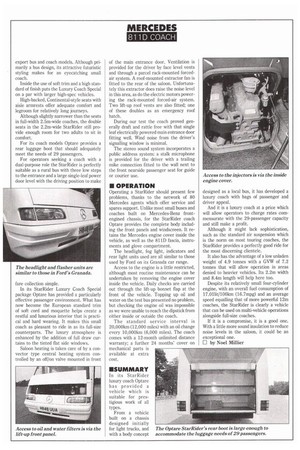MERCEDES
Page 26

If you've noticed an error in this article please click here to report it so we can fix it.
81 1D COACH
export bus and coach models. Although primarily a bus design, its attractive futuristic styling makes for an eyecatching small coach.
Inside the use of soft trim and a high standard of finish puts the Luxury Coach Special on a par with larger high-spec vehicles.
High-backed, Continental-style seats with aisle armrests offer adequate comfort and legroom for relatively long journeys.
Although slightly narrower than the seats in full-width 2.5m-wide coaches, the double seats in the 2.2m-wide StarRider still provide enough room for two adults to sit in comfort.
For its coach models Optare provides a rear luggage boot that should adequately meet the needs of 29 passengers.
For operators seeking a coach with a dual-purpose role the StarRider is perfectly suitable as a rural bus with three low steps to the entrance and a large single-leaf power door level with the driving position to make fare collection simple.
In its StarRider Luxury Coach Special package Optare has provided a particularly effective passenger environment. What has now become the European standard trim of soft cord and moquette helps create a restful and luxurious interior that is practical and hard wearing. It makes this small coach as pleasant to ride in as its full-size counterparts. The luxury atmosphere is enhanced by the addition of full draw curtains to the tinted flat side windows.
Saloon heating is taken care of by a convector type central heating system controlled by an off/on valve mounted in front
of the main entrance door. Ventilation is provided for the driver by face level vents and through a parcel rack-mounted forcedair system. A roof-mounted extractor fan is fitted to the rear of the saloon. Unfortunately this extractor does raise the noise level in this area, as do the electric motors powering the rack-mounted forced-air system. Two lift-up roof vents are also fitted; one of these doubles as an emergency roof hatch.
During our test the coach proved generally draft and rattle free with that single leaf electrically powered main entrance door fitting well. Wind noise from the driver's signalling window is minimal.
The stereo sound system incorporates a public address system; a stalk microphone is provided for the driver with a trailing mike connection fitted to the wall next to the front nearside passenger seat for guide or courier use.
• OPERATION
Operating a StarRider should present few problems, thanks to the network of 80 Mercedes agents which offer service and spares support. Unlike most small buses and coaches built on Mercedes-Benz frontengMed chassis, for the StarRider coach Optare provides the complete body including the front panels and windscreen. It retains the Mercedes engine cover inside the vehicle, as well as the 811D fascia, instruments and glove compartment.
The headlight, fog light, indicators and rear light units used are all similar to those used by Ford on its Granada car range.
Access to the engine is a little restricted, although most routine maintenance can be undertaken by removing the engine cover inside the vehicle. Daily checks are carried out through the lift-up bonnet flap at the front of the vehicle. Topping up oil and water on the test bus presented no problem, but checking the engine oil was impossible as we were unable to reach the dipstick from either inside or outside the coach.
The standard service interval is 20,000km (12,000 miles) with an oil change every 10,000km (6,000 miles). The coach comes with a 12-month unlimited distance warranty; a further 24 months' cover on mechanical parts is available at extra cost.
ESUMMARY
In its StarRider luxury coach Optare has provided a vehicle which is suitable for prestigious work of all types.
From a vehicle built on a chassis designed initially for light trucks, and with a body concept designed as a local bus, it has developed a luxury coach with bags of passenger and driver appeal.
And it is a luxury coach at a price which will allow operators to charge rates commensurate with the 29-passenger capacity and still make a profit.
Although it might lack sophistication, such as the standard air suspension which is the norm on most touring coaches, the StarRider provides a perfectly good ride for the most discerning clientele.
It also has the advantage of a low unladen weight of 4.9 tonnes with a GVW of 7.2 tonnes that will allow operation in areas denied to heavier vehicles. Its 2.2m width and 8.4m length will help here too.
Despite its relatively small four-cylinder engine, with an overall fuel consumption of 17.011it/100km (16.7mpg) and an average speed equalling that of more powerful 12m coaches, the StarRider is clearly a vehicle that can be used on multi-vehicle operations alongside full-size coaches.
If it is a compromise, it is a good one. With a little more sound insulation to reduce noise levels in the saloon, it could be an exceptional one.
0 by Noel Millier












































































